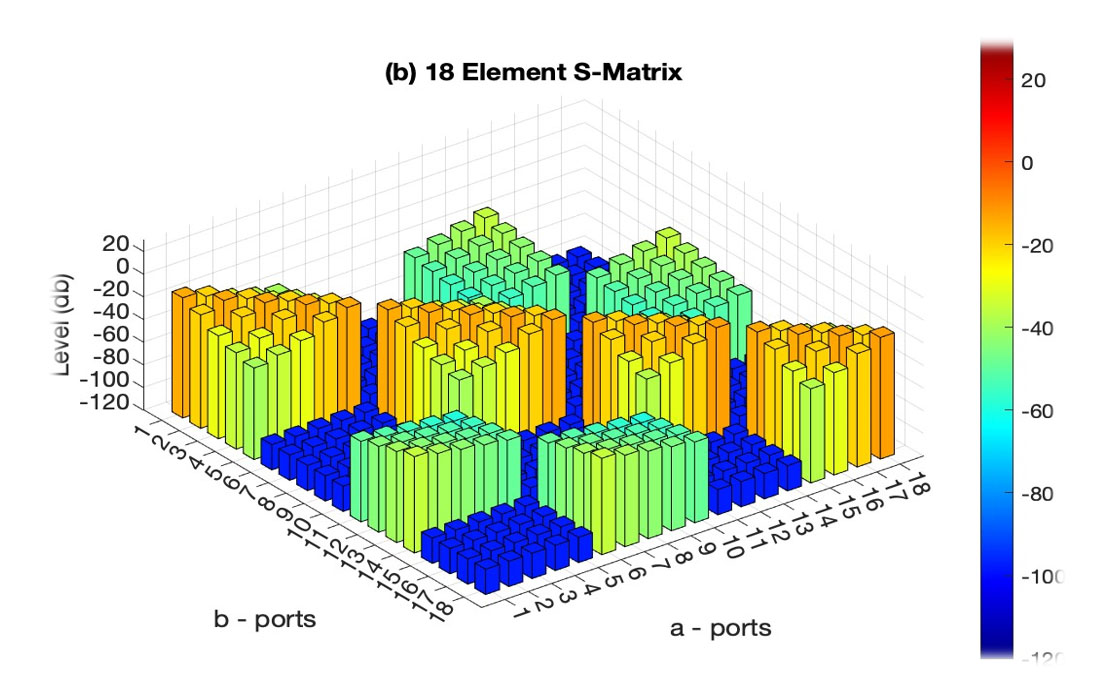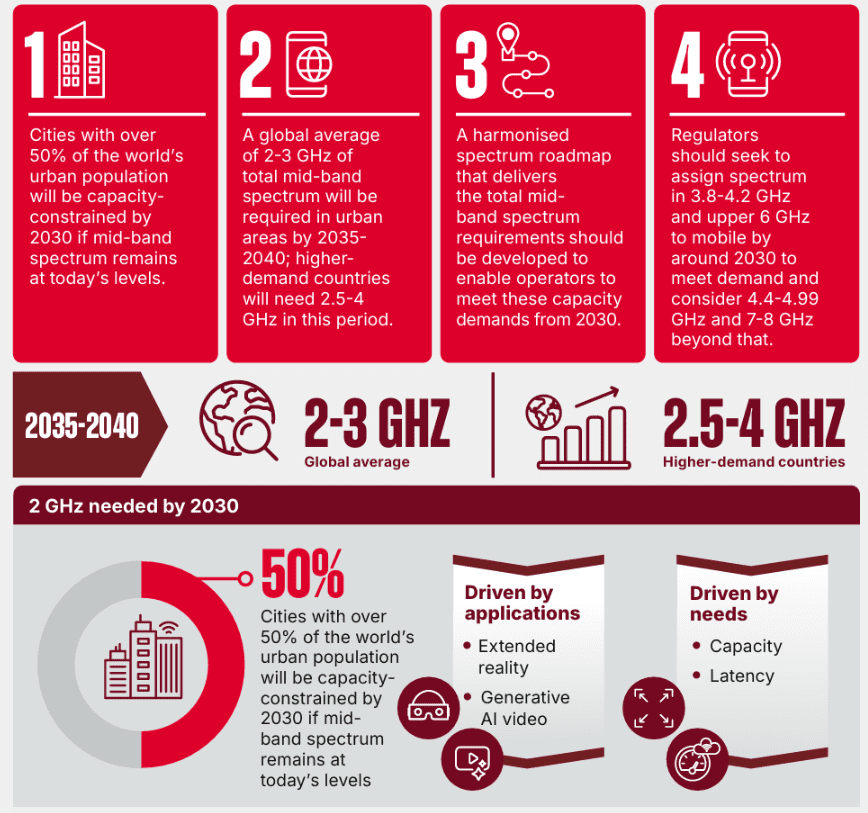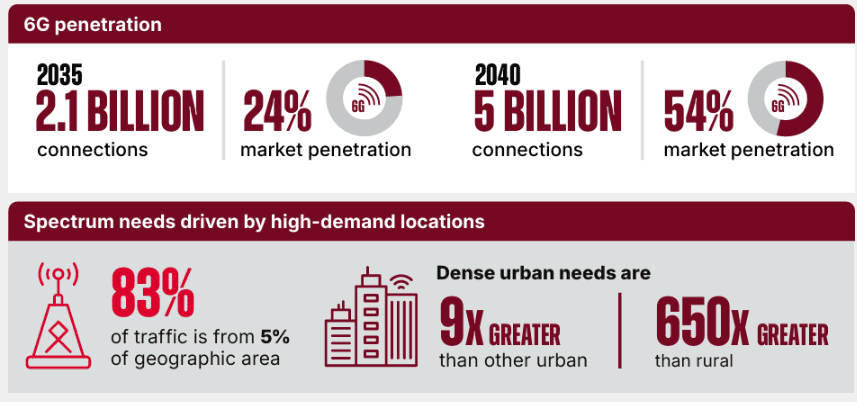Spectrum Crunch
GSMA Vision 2040 study identifies spectrum needs during the peak 6G era of 2035–2040
According to a recent GSMA Vision 2040 study, many cities worldwide could face capacity limitations by 2030 if mid-band spectrum availability does not increase, impacting over half of the global urban population. Strategic long-term planning for future wireless generations like 6G is necessary, as device and equipment development can take over a decade, with 6G expected to account for roughly 5 billion connections by 2040 while 4G and 5G remain prevalent. The GSMA’s modeling forecasts a significant rise in traffic, potentially reaching 4,000 EB/month by 2040 in a high-growth scenario driven by AI-enabled applications. The report’s analysis shows that countries must act now to secure enough spectrum for 6G, or risk slower speeds, rising congestion and lost economic opportunity in the 2030s.The GSMA cautions that without early government planning, consumers could face poorer connectivity, businesses may struggle to adopt new technologies, and national digital economies could lose competitiveness in the global transition to 6G.
“Next-generation 6G networks will require up to three times more mid-band spectrum than is typically available today to keep pace with surging demand for data, AI-powered services and advanced digital applications, according to new analysis published today by the GSMA, which represents the mobile ecosystem worldwide.”
John Giusti, Chief Regulatory Officer, GSMA:
“This study shows that the 6G era will require three times more mid-band spectrum than is available today. Satisfying these spectrum requirements will support robust and sustainable connectivity, deliver digital ambitions and help economies grow. I hope this report provides useful insights to governments as they strive to meet the connectivity needs of their citizens in the coming decade.”
Long-Term Spectrum Planning Underpins Enterprise Strategy:
Planning for 6G requires a substantial lead time; the report highlights that device ecosystem readiness and equipment development cycles often span a decade or more. Telecom operators must finalize decisions regarding fiber backhaul, Radio Access Network (RAN) upgrades, and site acquisitions years before new services go live. Enterprises developing AI-driven products or advanced mobility services rely heavily on this network predictability.
The report’s modeling suggests 6G will account for roughly 5 billion connections by 2040—approximately half of all global mobile connections. However, 4G and 5G will remain heavily utilized, particularly in emerging markets, making immediate spectrum re-farming impractical. Operators will increasingly rely on multi-RAT spectrum sharing (MRSS) to manage parallel generations of mobile technology. While MRSS offers improved efficiency over current dynamic spectrum sharing methods, coexistence introduces inherent operational complexity.
AI, Sensing, and the Power User Dynamic:
Demand is shifting toward intelligence-driven workloads, resulting in projected traffic growth across all GSMA scenarios. Even the most conservative projection forecasts 10% annual growth between 2030 and 2040, reaching 1,700 EB/month. The high-growth scenario predicts 4,000 EB/month, driven largely by AI-enabled applications.
The report identifies four primary channels through which Artificial Intelligence will impact traffic:
- New applications: including multimodal assistants.
- Performance demands: higher requirements for existing experiences like personalized video.
- Increased time online.
- Efficiency gains: some optimization through compression.
Enterprises implementing AI assistants, high-definition video, or hybrid cloud-edge processing will contribute significantly to this shift, requiring a focus on increased uplink demand.
A key behavioral finding is that 10% of users currently generate 60-70% of mobile traffic. As digitally-native generations mature, these usage patterns will become mainstream. Enterprise solutions for mobility, frontline workers, and customer engagement must be architected to handle these higher sustained uplink and downlink loads.
Geospatial analysis shows that 83% of traffic is concentrated in 5% of geographic areas. Dense-urban traffic can be nearly 700x higher per square kilometer than in rural areas. For enterprises operating in high-demand zones (e.g., logistics hubs, retail corridors, public venues), the localized performance of RAN deployments will determine service reliability and efficacy.
Mid-Band Spectrum as 6G’s Anchor Capability:
The GSMA study asserts that dense-urban areas will require 2-3 GHz of mid-band spectrum globally by 2035-2040, increasing to 2.5-4 GHz in higher-demand markets. Many regions currently provide only around 1 GHz, necessitating an additional 1-3 GHz allocation. The report stresses that at least 2 GHz must be operational by 2030 to prevent early 6G rollouts from facing immediate congestion.
This additional spectrum capacity enables several critical 6G capabilities:
- Low latency: Wide channels required for sub-10 ms latency supporting digital twins and real-time sensors.
- Balanced performance: Symmetrical uplink/downlink performance for real-time bi-directionality.
- Efficiency: Efficient reuse of existing bands via MRSS.
- Optimized deployment: Reduced reliance on mmWave, which is not economical for wide-area traffic coverage.
Operational Constraints to Manage:
- Densification Limits: Most urban networks operate optimally within inter-site distances of 200-800m. Further densification introduces rapidly escalating costs, making spectrum acquisition a more scalable solution.
- mmWave Role: Millimeter wave (mmWave) remains a supplementary technology, suitable for localized capacity but limited to carrying 5-10% of dense-urban traffic; it does not replace mid-band for wide-area coverage.
- Wi-Fi Offload: Due to its unmanaged nature, Wi-Fi offload cannot deliver the predictable performance guarantees required for mission-critical 6G-era applications.
- Gradual Re-farming: With 4G and 5G still prevalent through 2040, MRSS is essential for balancing capacity across generations of radio technology.
Recommendations for Telecoms Companies:
Telecom operators should develop a long-term spectrum roadmap informed by these findings, prioritizing 2-3 GHz globally, with targets up to 4 GHz in high-demand markets. Key actions include:
- Prioritize 6 GHz: Focus on the upper 6 GHz band, which offers approximately 700 MHz of new capacity between 6.425-7.125 GHz.
- Integrate MRSS: Build multi-RAT spectrum sharing into core network design to balance 4G, 5G, and 6G operations.
- Model Uplink Demands: Plan for greater asymmetric demands driven by future uplink-heavy workloads (e.g., enterprise AI, sensing).
- Address Vertical Needs: Prepare specific service level agreements (SLAs) for verticals such as manufacturing, transport, and retail that require guaranteed latency and reliability.
- Evaluate Densification: Utilize densification strategically in high-value, targeted areas rather than as a broad replacement for acquiring additional spectrum.
Conclusions:
Spectrum policy directly translates to concrete operational outcomes. A city or nation’s ability to deliver reliable 6G performance will be a key determinant of future economic growth and service innovation. For both telecom operators and enterprise technology leaders, aligning current investment strategies with critical spectrum decisions is essential for defining next-generation connectivity infrastructure. The full study is available on the GSMA Intelligence website.
Editor’s Note:
ITU-R is the SDO (Standards Development Organization) that defines the framework, requirements, and evaluation criteria for IMT-2030 (6G) systems, which includes identifying the necessary spectrum. The WRC-23 identified key frequency ranges (e.g., 4400-4800 MHz, 7125-8400 MHz, and 14.8-15.35 GHz) for further study for IMT-2030 under a WRC-27 agenda item.
After WRC determines the IMT 2030 frequencies, ITU-R WP 5D will develop a recommendation for IMT 2030 Frequency Arrangements, just as it did for IMT 2020, but it was delayed due to bickering and only was finalized after the ITU-R M.2150 recommendation (IMT 2020 RIT/SRITs) was approved. Specifically, ITU-R M.1036-7 provides harmonized frequency bands to facilitate global roaming and economies of scale, while acknowledging that specific national band plans may vary due to existing services.
References:
https://www.telecomstechnews.com/news/the-spectrum-decisions-shaping-gsma-6g-era-report/
Big 5G Conference: 6G spectrum sharing should learn from CBRS experiences
India’s TRAI releases Recommendations on use of Tera Hertz Spectrum for 6G
WRC-23 concludes with decisions on low-band/mid-band spectrum and 6G (?)
https://www.itu.int/en/ITU-R/study-groups/rsg5/rwp5d/imt-2030/pages/default.aspx
Do ITU Radio Regulations Matter? China allocates 6 GHz spectrum for 5G and 6G services prior to WRC 23; CTIA objects!
Gartner: Gen AI nearing trough of disillusionment; GSMA survey of network operator use of AI
GSMA: China’s 5G market set to top 1 billion this year
Highlights of GSMA study: Mobile Net Zero 2024, State of the Industry on Climate Action
GSMA- ESA to collaborate on on new satellite and terrestrial network technologies
GSMA: Closing the digital divide in Central Asia and the South Caucasus
InterDigital led consortium to advance wireless spectrum coexistence & sharing
InterDigital, Inc, a mobile, video and AI technology research and development company, was awarded a contract by the U.S. Department of War (DoW) to lead research and conduct demonstrations of advanced spectrum coexistence for civil and military applications. Spectrum sharing optimizes the use of the airwaves, or wireless communications channels, by enabling multiple categories of users to safely share the same frequency bands.
A consortium led by InterDigital, including DeepSig, Skylark Wireless, Virginia Tech, and Radisys, will endeavor to advance spectrum coexistence. The collaboration will focus on developing and testing new technologies that leverage artificial intelligence, advanced sensing, and commercial 5G systems. The need for this work stems from the high demand for mid-band frequencies, which are essential for both defense radar and commercial wireless applications due to their balance of coverage and capacity. The goal is to enhance dynamic spectrum sharing performance, ensuring national security radar systems can function without interference while enabling commercial 5G to operate in the same frequency bands.
The consortium plans to develop new technologies that will enable government and industry systems to “more seamlessly coexist.” Examples are given as low-latency AI-based distributed spectrum sensing and interference mitigation operations performed locally at cellular base stations and user equipment.
“InterDigital’s heritage of research has produced innovations that make it possible for radar and communications to coexist in ways that were not feasible,” said InterDigital CTO Rajesh Pankaj. “Building on our groundbreaking work in sensing and AI integration, we can foster greater collaboration between government and industry to achieve more efficient sharing of one of our most valuable resources. We look forward to working with the DoW and alongside these esteemed partners and suppliers.”
“DeepSig is proud to support the DoW and InterDigital in advancing dynamic spectrum sharing technologies,” said DeepSig CEO Jim Shea. “Our AI-native spectrum sensing and communications software was developed to help meet this need and brings the speed, accuracy and adaptability needed to ensure that critical defense systems and commercial 5G networks can safely and efficiently coexist. This project represents an important step toward unlocking the full potential of mid-band spectrum for both national security and next-generation connectivity, and offers to help unlock future band-sharing for 6G and beyond.”
Skylark Director of Business Development & Product Samir Rahi added: “Skylark is pleased to have been selected as a collaborator for the DoW and InterDigital’s coalition of US-based partners to support dynamic spectrum-sharing solutions. This activity builds upon Skylark’s prior success in related DoW programs. Specifically, our flexible architecture for last-mile connectivity is designed to integrate best-of-breed technologies in real-time, from partners such as InterDigital and DeepSig, at the pace of innovation required to support national interests. Skylark believes the DoW’s initiatives such as this represent the United States’ emerging capabilities in deploying dynamic spectrum-sharing at scale, providing dual use benefits for the commercial sector while simultaneously advancing national security objectives.”
…………………………………………………………………………………………………………………………………………………………………………
This project will leverage InterDigital’s proven foundational dynamic spectrum sharing technologies, which have been successfully demonstrated in commercial deployments and validated through prior government initiatives. The team will build upon this baseline with new and innovative technologies, including low-latency AI-based distributed spectrum sensing and interference mitigation operations performed locally at cellular base stations and user equipment. These new technologies will enable government and industry systems to more seamlessly coexist.

Image Credit: Blue Planet Studio SHUTTERSTOCK
……………………………………………………………………………………………………………………………………………………………..
About InterDigital®
InterDigital is a global research and development company focused primarily on wireless, video, artificial intelligence (“AI”), and related technologies. We design and develop foundational technologies that enable connected, immersive experiences in a broad range of communications and entertainment products and services. We license our innovations worldwide to companies providing such products and services, including makers of wireless communications devices, consumer electronics, IoT devices, cars and other motor vehicles, and providers of cloud-based services such as video streaming. As a leader in wireless technology, our engineers have designed and developed a wide range of innovations that are used in wireless products and networks, from the earliest digital cellular systems to 5G and today’s most advanced Wi-Fi technologies. We are also a leader in video processing and video encoding/decoding technology, with a significant AI research effort that intersects with both wireless and video technologies. Founded in 1972, InterDigital is listed on Nasdaq.
InterDigital is a registered trademark of InterDigital, Inc.
For more information, visit: www.interdigital.com.
InterDigital Contact:Roya StephensEmail: [email protected] +1 (202) 349-1714
About DeepSig, Inc.DeepSig is a pioneer in AI native wireless communications which are helping to shape 6G. Its transformative technology pushes the boundaries of spectrum sensing, wireless performance and network capabilities. Drawing on its expertise in deep learning, wireless systems and signal processing, DeepSig’s AI/ML-powered software enhances security, efficiency and capacity for tactical and commercial wireless communications in licensed or shared radio spectrum and in existing 5G Open RAN or AI native next generation 6G networks.
For more information, visit: https://www.deepsig.ai/
DeepSig Contact: [email protected]
About Skylark Wireless
Skylark Wireless is building the interface between the physical and digital worlds by connecting industrial, enterprise, and public sector customers through a dynamic, converged communications platform. The company designs and manufactures US-assembled critical infrastructure for last-mile connectivity that combines patented techniques to improve range, performance, and interference mitigation with a fully software-defined radio architecture. This fusion of efficiency and flexibility uniquely supports an ever-growing collection of value-add use cases as networks evolve from 5G to 6G and beyond. To learn more about Skylark’s connectivity solution, please contact [email protected]
………………………………………………………………………………………………………………………………………………………
Other Spectrum Activities:
- Earlier in 2025, the GSMA’s global 5G spectrum landscape stated mid-band remains the backbone of 5G deployments, while interest in both low-band and mmWave “continues to evolve in line with network strategies and future 6G planning.”
- ITU-R WP 5D develops the methodologies for carrying out sharing and coexistence studies between IMT and other radio services, such as broadcasting and satellite services. These studies address issues like potential interference and define separation criteria and technical conditions for coexistence.
- WP 5D’s work also addresses the evolution of spectrum management to incorporate more efficient techniques like dynamic spectrum access (DSA).
- As part of its process, WP 5D collaborates with and receives input from various external organizations, research communities, and other ITU-R Working Parties. This collaborative approach ensures that the spectrum management and coexistence frameworks for IMT systems are robust and informed by diverse perspectives.
References:
InterDigital to Lead Research and Demonstrate Advanced Spectrum Coexistence; DeepSig to Partner
https://www.nist.gov/spectrum-sharing
Why Spectrum Sharing is Critical for the Future of Connectivity
mmWave Coalition on the need for very high frequency spectrum; DSA on dynamic spectrum sharing in response to NSF RFI
Big 5G Conference: 6G spectrum sharing should learn from CBRS experiences
Sharing of lower 3 GHz band in U.S. is unclear after DoD redacted report
The U.S. wireless industry would like to use the lower 3 GHz band, but it’s currently occupied by the military. The DoD says sharing between federal and commercial systems is not feasible unless certain conditions are met. Sharing between federal radar and mobile systems presents unique challenges, especially for airborne operations.
The DoD acknowledges the potential of freeing up some of the spectrum for 5G use, emphasizing that in order to make the lower 3 GHz band available for commercial use a “coordination framework must facilitate spectrum sharing in the time, frequency, and geography domains,” notes Broadband Breakfast.

5G already coexists with U.S. military systems in the lower 3 GHz band in more than 30 countries, said Umair Javed, CTIA senior vice president-spectrum. However, the future of the lower 3 GHz band in the U.S. is unsettled following DoD’s public release last week of a redacted version of its Emerging Mid-Band Radar Spectrum Sharing Feasibility Assessment [1.].
Note 1. Emerging Mid-Band Radar Spectrum Sharing Feasibility Assessment report
This redacted DoD report examines military systems located in lower 3 GHz spectrum, with an eye on potential sharing but not on clearing as sought by CTIA and carriers. It concludes that sharing the 3.1-3.45 GHz band between federal and commercial systems is not currently feasible “unless certain regulatory, technological, and resourcing conditions are proven and implemented.” The report originally came out in September 2023.
…………………………………………………………………………………………………………………..

DoD Chief Information Officer John Sherman said in February the department is willing to consider clearing part of the band “perhaps for future airborne radars,” which wasn’t part of EMBRSS. The spectrum is home to the Airborne Warning and Control System (AWACS), which DOD is upgrading. Airborne radars are considered the most difficult to address in a sharing regime because they are so mobile.
The lower 3 GHz is one of a few bands allowing for military radars “with small enough antenna apertures” to be mobile, with “sufficient range capabilities to serve as medium and long-range radars,” the study says. It notes the propagation characteristics of mid-band spectrum, which also make it a top target of carriers. “A complicating factor … has been the increased packing of federal systems relocated from other bands, including those as a result of repurposing from previous auctions,” the study says.
DoD found that more than 120 different ground-based, ship-borne and airborne radars use the band. While details are redacted, the report offers basic information on how the bands are used, for everything from land-based radar for tracking threats to Coast Guard and Navy search and rescue missions to air-traffic control to tracking bird migrations with an eye toward avoiding collisions. It also discusses the Department of Homeland Security’s uses.
But EMBRSS says sharing is possible using a dynamic spectrum management system (DSMS). It cites sharing in the citizens broadband radio service band. A DSMS, which “evolves the CBRS framework … with advanced interference mitigation features” addressing the unique needs of airborne systems, “provides a feasible path forward for spectrum sharing between the Federal and commercial systems,” EMBRSS said.
Blair Levin wrote Wednesday in a note to New Street clients.:
“The report’s most significant implications for investors involve what the DOD report did not do. It did not resolve any issues or provide a timetable for doing so. Thus, we remain far from resolving the question of where the spectrum that the wireless carriers argue they will need by 2027 will come from. While some advocate exclusive licensing of the band, and others sharing, DOD “almost certainly retains a veto power over any potential outcome,” he said.
DoD leaders, including John Sherman, the Pentagon’s top IT official, met Monday with the National Spectrum Consortium, a group of more than 350 members of academia and industry who work with the electromagnetic spectrum, to take the first steps to outline a framework to share the bandwidth with industry and to kickstart a discussion on a spectrum management program.
“No surprise. We know that spectrum will be challenging,” said Kevin Mulvihill, the Pentagon’s deputy chief information officer for command, control and communications. “But we need to work together across industry, government and academia to explore potential ways to achieve spectrum coexistence for the benefit of the entire nation while ensuring that the spectrum sharing that we choose does not negatively affect the primary mission of the Department of Defense.”
References:
https://dodcio.defense.gov/Portals/0/Documents/Library/DoD-EMBRSS-FeasabilityAssessmentRedacted.pdf
https://www.fierce-network.com/5g/dod-releases-long-awaited-report-lower-3-ghz
If the Pentagon has to share 5G spectrum, it wants some new ground rules – Breaking Defense
mmWave Coalition on the need for very high frequency spectrum; DSA on dynamic spectrum sharing in response to NSF RFI
According to the mmWave Coalition, most 5G and 6G discussions to date are focused on lower frequencies. “A key reason for this is that it is hard to justify a business case for sub-THZ mobile spectrum use at present as there are now basic technical questions, technological hurdles, and cost issues, yet these are fertile and active areas of research which may eventually lead to compelling opportunities for mobile use in this spectrum.”
Policymakers shouldn’t forget the potential of very high frequency spectrum [1.], the Coalition said last week in response to the National Science Foundation’s request for information (RFI) on the national spectrum research and development plan, which is part of the U.S. national spectrum strategy. The Coalition wrote:
“5G and 6G in US policy deliberations addresses both fixed and mobile users, and the 5G and 6G mobile uses are dependent on fronthaul and backhaul which are essentially fixed services. While these fixed links are often implemented in non-spectrum fiber optic links, there is a vast, growing need for wireless backhaul, especially in rural, underserved areas often where fixed wireless access is vital for rural households, and often backhaul requirements cannot always be implemented in fiber technology, due to installation urgency requirements, local terrain features that delay or block installation, cost, or short term requirements that make fiber optic installation uneconomical”
Note 1. ITU-R Report R M.2376 contains studies of frequency ranges (6-100 GHz) for International Mobile Telecommunications (IMT) technologies. It is envisioned that future IMT systems will need to support very high throughput data links to cope with the growth of the data traffic, new extremely bandwidth demanding use cases, as well as new capabilities of integrated sensing and communication (ISAC). There has been academic and industry research and development ongoing related to suitability of mobile broadband systems in frequency bands above 92 GHz to enable services requiring tera-bit per second speeds. This has prompted researchers to consider the technical feasibility of higher frequency bands in IMT.
An ITU-R preliminary draft new report in progress provides information on the technical feasibility of IMT in bands between 92 GHz and 400 GHz. This draft report complements the studies carried in Report ITU-R M.2376.
……………………………………………………………………………………………………………………….
The Dynamic Spectrum Alliance (DSA) said the RFI is on target in the areas it suggests for research. “Efficiency, dynamic spectrum access and management, automated interference mitigation, and coexistence modeling are all areas in which the DSA and our members have keen interest and extensive experience. We also fully support efforts to study the economic-, market-, social-, and human-centric aspects of increasing spectrum access.”
DSA called on the NSF to take into account innovative licensing frameworks that are already working, including the citizens broadband radio service band and 6 GHz. “Given the historical success of the variety of spectrum sharing techniques in different bands designed to protect different incumbents … there is no one size fits all solution to spectrum sharing,” DSA said.
One term of interest is ‘‘Dynamic Spectrum Sharing’’ which is a focus of the National Spectrum Strategy but was not defined. The DSA defines Dynamic Spectrum Sharing as the use of both innovative licensing frameworks, such as those that enable opportunistic access, and automated dynamic spectrum management tools to coordinate spectrum assignments, increase spectrum efficiency, and expand spectrum access for a wide range of new users while also protecting incumbent operations.

Dynamic Spectrum Sharing between 4G and 5G Networks
………………………………………………………………………………………………………
AT&T urged the administration to more clearly define the term dynamic spectrum sharing. The definition should include an “examination of full-power licensed use” and “development of a basis for predictable times and/or geographies in which dynamically shared spectrum can be used,” AT&T said.
The U.S. carrier urged more work on interference mitigation techniques and not restricting research to “mere ‘on/off’ spectrum access controls.” The definition should seek “to define co-channel and adjacent channel interference environments to incorporate into network design and operation.”
References:
https://communicationsdaily.com/article/view?search_id=838690&id=1914125
https://s3.amazonaws.com/warren-news.com/pdf/916759
https://dynamicspectrumalliance.org/2024/DSACommentstoNSFonSpectrumRnDPlanRFI.pdf
New ITU report in progress: Technical feasibility of IMT in bands above 100 GHz (92 GHz and 400 GHz)
ITU-R WP5D: Studies on technical feasibility of IMT in bands above 100 GHz
Telstra achieves 340 Mbps uplink over 5G SA; Deploys dynamic network slicing from Ericsson
Vodafone tests 5G Dynamic Spectrum Sharing (DSS) in its Dusseldorf lab
Keysight Technologies, Qualcomm extend 5G Collaboration to Dynamic Spectrum Sharing (DSS) Technology
Ericsson 5G data call using dynamic spectrum sharing with Qualcomm 5G Modem-RF System
Could Transpositional Modulation be used to solve the “spectrum crunch” problem
Transpositional Modulation (TM) permits a single carrier wave to simultaneously transmit two or more signals, unlike other modulation methods. It does this without destroying the integrity of the individual bit streams.
TM Technologies (TMT) is a wireless technology company offering dramatic data throughput increases for existing wireless and wired networks, using TM.
TMT’s In Band Full Duplex (IBFD) is a MIMO-compatible antenna and software technology providing signal interference cancellation via its Adaptive-Array Antenna which allows simultaneous transmit and Receive = Doubling Data Rates. TM-IBFD development has shown a combined 120 db noise reduction in two-way communications, which provides up to a 100% gain in wireless data transport efficiency.
TMT believes that the use of its patented methods can prevent or delay the onset of a wireless “bandwidth crunch” and focuses on developing products for a range of applications. These products will use core technology to provide solutions and create value for customers, the economy, and the global wireless infrastructure. The company says that the TM-IBFD is backwards compatible and complimentary with existing beam forming or beam shaping installations.

Image Courtesy of TM Technologies (TMT)
……………………………………………………………………………………………………………………………………..
Using the latest Xilinx RFSoC devices, TMT has produced a Software Defined Radio (SDR) format with OFDM as primary modulation with multiple TM channel overlays. This is applicable to nearly any access or backhaul radio device with adequate head-space and operating within the 3GPP Rel 16 specifications.
Industry analyst Jeff Kagan wrote: “Spectrum shortage remains a problem that is not going to solve itself. That’s why new solutions like this are necessary….In the case of solving this spectrum crisis, there are two different groups to focus on. One, is the wireless carriers. Two, are wireless network builders. Either, the customer, which is the wireless network needs to demand this from their network builders. Or the network builders need to embrace this as a competitive advantage and as a solution to their customers.”

Jeff Kagan
References:
Kagan: Could TM Technologies help solve wireless spectrum shortage?




